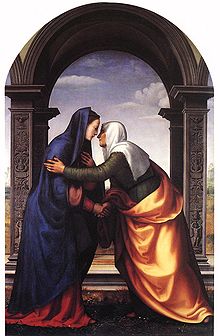 Mariotto di Bigio di Bindo Albertinelli (October 13, 1474 – November 5, 1515) was a High Renaissance Italian painter of the Florentine school, closely involved with Fra Bartolomeo and influenced by Raphael.
Mariotto di Bigio di Bindo Albertinelli (October 13, 1474 – November 5, 1515) was a High Renaissance Italian painter of the Florentine school, closely involved with Fra Bartolomeo and influenced by Raphael.Mariotto was a most restless person and carnal in the affairs of love and apt to the art of living, and, taking a dislike to the studies and brain-wracking necessary to painting, being also often stung by the tongues of other painters, as is their way, he resolved to give himself to a less laborious and more jovial profession, and so opened the most lovely hostelry outside the Porta San Gallo, and at the sign of the Dragon at the Ponte Vecchio a tavern and inn. This life he led for many months, saying that he had taken up an art that was without muscles, foreshortening or perspective and, better still, without faultfinding, and that the art that he had given up imitated flesh and blood, but this one created flesh and blood; in this if you had good wine you heard yourself praised, but in that every day you were blamed. But at last the low life became an annoyance to him, and, filled with remorse, he returned to painting.
Albertinelli's paintings bear the imprint of Perugino's sense of volumes in space and perspective, Fra Bartolomeo's coloring, the landscape portrayal of Flemish masters like Memling, and Leonardo's Sfumato technique. His chief paintings are in Florence, notably his masterpiece, the Visitation (1503) at the Uffizi (illustrated right).
Mariotto Albertinelli select paintings:

